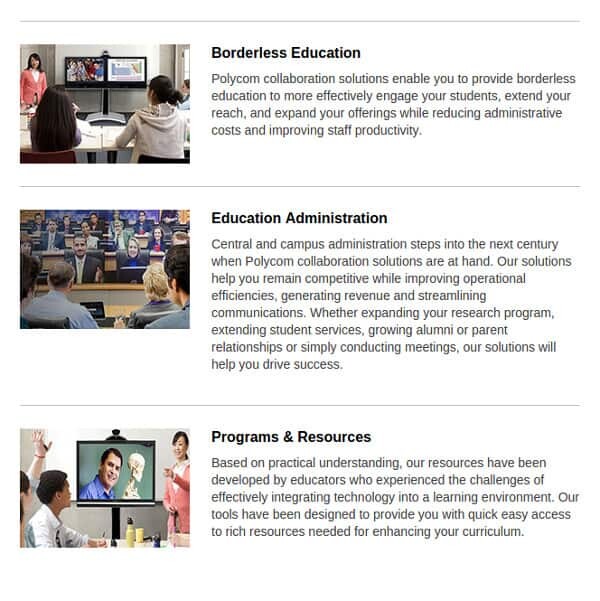WebRTC makes things a lot more… personal.

I come from the video conferencing industry. At one point in time, to get beyond the single use case of connecting the multinational enterprise sites to each other, the vendors started marketing their products by verticals. The usual suspects were government, healthcare, education, etc.
The education one? It was all about large screens in class rooms. And guess what – this haven’t changed at all. I went to check Polycom’s website and their Education vertical solution. Here’s what you see there:

Check out other traditional enterprise video conferencing players and you will probably see the same types of solutions – large screens for large class rooms. The reason stems from the roots of the video conferencing industry, which is based on the notion of meeting rooms and expensive equipment.
The end result is simple – it reduces the problem set that video conferencing handle to a select few. WebRTC changes that. Drastically.
I want to share here two recent education related startups that I’ve been made aware of. Both use WebRTC. Both do something that is starkly different than the traditional players.
Vedantu
Vedantu was a lesson in humility for me. I have never been to India, but the stereotype for me is clear: a billion people living in poverty – whatever you do – you do with masses – and at the lowest price point possible. Vedantu offers online tutoring lessons for their local market in India. They do it through private lessons tutoring. Paid for. The opposite of what masses mean. I should have known better – a billion people can’t be a flat population.
What is interesting with Vedantu is that they use WebRTC to do the lessons. They care about the voice more than they do about the video part. And they care about the whiteboard/sharing aspect. Both teacher and student enter the system and from there they interact online – each from the comfort of his own device – desktop, laptop or mobile.
The challenges they need to face are starkly different than the classroom paradigm of the enterprise-video-conferencing-education-vertical. They deal with 1:1 interactions. They need to handle session recordings, payment, teacher ratings, exams, etc.
They also need to deal with the realities of the network in India – if you can get a decent connection for half an hour – you are lucky. How do you factor that into a service built around VoIP? The user experience is different than that traditionally found in the US and Europe.
Kwiizi
If Vedantu was interesting, then what would you say about Kwiizi? An open source initiative in Cameroon, Africa. The idea is to “allow educational institutions to obtain millions of articles, books and videos for education while providing a communication platform where you can even make video calls. All without internet connection.”
Oh, and they do it on a Raspberry Pi – to make sure costs for the end users are the lowest possible.
WebRTC here isn’t part of the tutoring system itself. Or at least not directly. It is used as a social network. As the website states: “Stay tuned to the newsfeed of your class; communicate with friends and teachers. Share what you see.Video calls will make the experience more better.”
Picture doing that with an enterprise grade room system.
The Experts marketplace
The experts marketplace is something I covered here in the past. LiveNinja and PopExpert interviewed here. The idea is that you have a profession or knowledge to share with others – you can do it online through a video call. But the website offers much more than the video call itself: aggregation of experts, search, rating, scheduling, payment, etc.
There are specialized marketplaces – of doctors, developers, musicians, …
This in a way is education related. Not the classroom and grades type of education, but when did one size fits all ever fit all?
For more on the marketplace use case and generality versus niche check out the great article on TokBox’ blog: Google Helpouts wasn’t helping
Why is this important?
- WebRTC goes far beyond the scope and breadth of enterprise video conferencing solutions
- It is used to open up new use cases that weren’t possible before
- It enables vendors who know their specific market (education in India or Cameroon in the examples above) to tailor a solution fit for purpose
